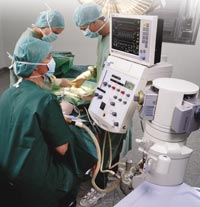| Home : ITU News magazine | |||||||
The term e-health incorporates some elements of telemedicine — that is, the use of telecommunication tools, coupled with medical expertise, to deliver diagnostic, therapeutic and educational services to individuals living some distance from medical facilities. But it is generally agreed that e-health is more than that. It includes the electronic background tasks that make the medical world tick, and the technical wizardry that is behind the systems which allow, for example, the sharing of medical expertise and radiology information. In short, the term “e-health” encompasses all of the information and communication technologies (ICT) necessary to make the health system work. Opening the workshop, Houlin Zhao, Director of the Telecommunication Standardization Bureau (TSB) said that “…standardization in e-health has long been sought as a key element in support of traditional health-care”. There are many generic standards used in e-health applications for video coding, security, multimedia transmission and languages for instance. Most of those standards have been developed by ITU–T. However, there is a perceived lack of coordination in e-health specific standards — a key problem that the workshop addressed. Stronger coordination: an imperativeAmong the 114 participants from 41 countries (including 25 developing nations) were representatives from telecommunication system manufacturers, system integrators, end-users and ICT professionals within the medical profession, international and intergovernmental organizations, university hospitals, medical associations and non-governmental organizations. Workshop sessions included a combination of case studies highlighting end-user requirements and discussion on a number of technical issues and priorities that needed to be addressed for e-health to prosper. Many speakers agreed that standardization in e-health is a way to increase levels of interoperability, but, a number of others also agreed that there are too many standards and that these are either not deployed or are conflicting, introducing competing solutions for similar problems. A stronger coordination of the standardization effort is seen by many as imperative.
ITU–D has been involved in many activities related to telecommunication in healthcare from the time of the World Telecommunication Development Conference (WTDC) in 1994. Following that event, several e-health/ telemedicine projects were implemented in developing countries demonstrating the benefit of such applications. However, many system vendors were shown to be promoting telemedicine systems of a proprietary nature, meaning that with no interoperability, medical institutions were often locked into buying one company’s products. In his opening speech at the event, Hamadoun I. Toure, Director of the Telecommunication Development Bureau (BDT), likened the situation to fiefdoms in medieval times.
Ole Bergsten, Head of the Clinical Engineering Department at the Copenhagen University Hospital, said: “At the moment, it is possible for me to want to share information with another hospital and face the possibility that because they are using equipment based on a different standard I may lose some quality of definition or other general degradation, and in healthcare that is not acceptable.” Mr Bergsten, along with many others, believes that a best practice document outlining the pros and cons of given standards in particular situations would be a good idea. The problem, however, according to Horst Siebold, coordinator of international activities at IEC TC 62, is that such a task would be too big an undertaking for one entity. He says that there are documents that already go part way to addressing the issue — the German Government for instance produces guidelines for best practice in e-health — but these are generally parochial in nature, or not wide reaching enough to cover all facets of e-health. Case studies may help create more meaningful standardsMelvin Reynolds, speaker at the event and Vice Convener of ISO TC215/WG2 (“Messaging and Communications”), argues that standards makers should, more and more, take into account case studies: “I talked to two nurses who were running a telemedicine project with European Union funding in Northern Sweden and Scotland. The aim was to offer better access to healthcare information and diagnostic and therapeutic advice. They had one big problem. Every system that they ran used a proprietary means of communication. Each application took up a whole personal computer (PC), and so you had this great wall of PCs — none of which could talk to each other.” Most participants agreed that giving case studies greater attention would lead to the creation of more meaningful standards. All agreed that the developing world is an important consideration in the development of e-health applications and standards. Ousmane Ly, a doctor from Mali, made a presentation about a telemedicine project in his country and highlighted the importance of interoperability in the environment of developing countries, where different underlying technologies may coexist. Some very robust de facto standards already exist, for example, DICOM (Digital Imaging and Communications in Medicine) and HL7 (Health Level 7). Most workshop participants agreed that events that brought together all players can only help drive future standardization work and give it better focus while making sure that duplication of effort is kept to a minimum. WHO representative, Andrei Issakov congratulated ITU for its initiative, pointing out that WHO considers e-health as a very valuable tool for medical professionals and as an innovation that will have an important and positive social impact. Workshop agrees to set up a joint coordination group
An important conclusion of the event was the agreement to create a joint coordination group for standardization in e-health, whose task will be to increase information exchange about ongoing standards activities in the respective organizations, avoid duplication and enhance cooperation. Subsequent to the event, ITU–T Study Group 16 has agreed to set up an e-health study project, which will look at standardization of multi-media systems to support telemedicine applications, underlining the importance given by ITU to this new and exciting area.
|
|||||||

